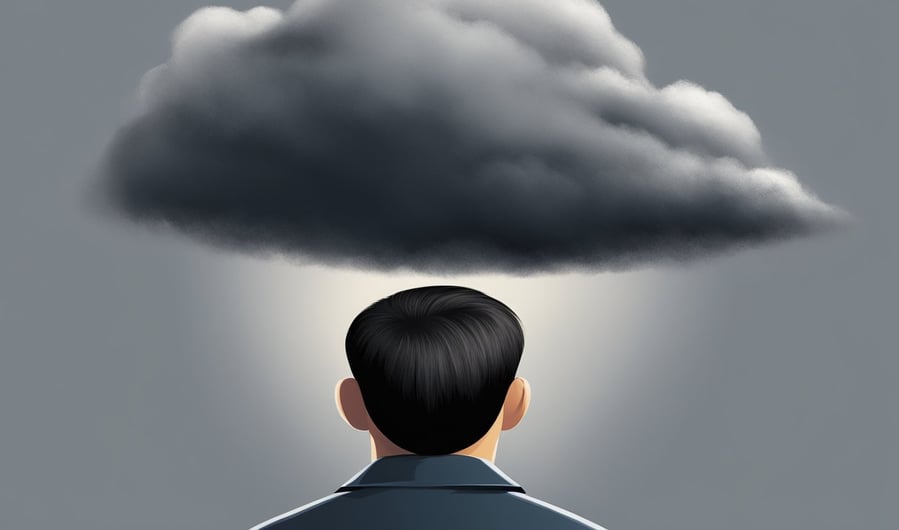What Are the Early Signs of Depression and How to Spot Them Easily?
Explore the early indicators of depression and gain insights on how to recognize them. Equip yourself with essential tools for mental health awareness.
MENTAL HEALTH
3/2/20258 min read


What Are the Early Signs of Depression and How to Spot Them Easily?
Depression can creep up on anyone, and often it does so quietly. Many people might not realise they are experiencing the early signs until they become overwhelming. Recognising these early signs of depression is crucial, as it allows individuals to seek help before it worsens. Awareness can lead to better mental health and a more fulfilling life.
For instance, someone might start to lose interest in activities they once enjoyed. They may also notice changes in their sleep patterns or appetite. These subtle hints can be easy to overlook, yet they play a significant role in a person’s overall well-being. Understanding these signs can empower individuals to take action for their mental health.
Talking about depression isn’t always easy, but it’s important to normalise the conversation. Everyone deserves support and to feel heard in their struggles. By exploring the early signs of depression, readers can become more equipped to help themselves or others who might be facing similar challenges.
Key Takeaways
Recognising early signs of depression can lead to timely support.
Changes in interests or sleep may indicate an issue.
Open conversations around mental health can reduce stigma.
Understanding Depression
Depression is a common mental health issue that affects many people. It can take different forms and has various signs that many might not recognise at first. Exploring its definition, types, and misconceptions sheds light on this serious condition.
Defining Depression
Depression is more than feeling sad. It’s a persistent condition that can impact daily life. Major Depressive Disorder (MDD) is the most recognised form. It involves feelings of hopelessness, loss of interest, and changes in sleep and appetite lasting for weeks or more.
Other symptoms may include difficulty concentrating and fatigue. This can affect relationships and work. Understanding these signs can help in recognising when someone might need support. It is important to realise that depression is a health issue, not a character flaw.
Types of Depression
There are several types of depression. Each type has its own features and treatment options.
Major Depressive Disorder: Characterised by severe symptoms that affect daily functioning.
Bipolar Disorder: Involves mood swings between high energy and deep sadness.
Persistent Depressive Disorder: A chronic form of depression lasting for two years or more.
Seasonal Affective Disorder (SAD): Linked to seasonal changes, often occurring in winter.
Knowing these types helps people seek appropriate help. Treatments can differ based on the type of depression, making it essential to learn more about specific conditions.
Common Misconceptions
There are many misconceptions about depression that can lead to misunderstanding.
"It’s just a phase": People often think those with depression can easily snap out of it. This is not true; depression can persist without treatment.
"Only sad people get depressed": Many assume depression only affects those who seem sad or withdrawn. In reality, it can affect anyone, regardless of their outward behaviour.
"Medication is the only option": While medication can help, therapy and lifestyle changes are also effective.
Addressing these misconceptions is crucial for providing support and encouraging open conversations about mental health. It helps create a more understanding environment for those who suffer from this illness.
Recognising the Early Signs
Early signs of depression can show up in various ways. Emotional, behavioural, and physical symptoms often overlap, making it important to pay attention to them. Recognising these signs can lead to early intervention and support.
Emotional Symptoms
Emotional symptoms are key indicators of depression. People may experience persistent sadness that lasts for weeks. This isn’t just a bad day; it’s a heavy weight that doesn’t lift. A person might also feel irritable or angry over small matters. This irritability can disrupt daily life and relationships.
A feeling of hopelessness is another common sign. It may seem like there's no way out of dark thoughts. Additionally, individuals might lose interest in activities they once loved, a symptom known as anhedonia. This emotional numbness often leads to loneliness, creating a cycle that can be hard to break.
Behavioural Indicators
Behavioural changes can also signal early depression. One of the first things noticed might be a decline in motivation. Tasks that used to seem simple now feel overwhelming. Procrastination becomes common, leading to unfinished work.
People may also withdraw from social activities or friendships. This isolation often feeds feelings of loneliness and makes it harder to reach out for help. Some might turn to unhealthy coping mechanisms, such as increased alcohol or drug use, further complicating the situation.
Lastly, difficulty with concentration and focus can occur. Simple decisions may seem exhausting, and this can affect work or school performance.
Physical Symptoms
Physical symptoms can be quite telling as well. Constant tiredness or a lack of energy is frequent among those experiencing depression. Even a full night’s sleep may not restore energy levels.
Problems like insomnia or wanting to sleep all day become common struggles. This fatigue can lead to further emotional challenges.
Other signs might include changes in appetite—either eating more or less than usual. Weight fluctuations may occur because of this. Some individuals also report unexplained aches and pains. These physical symptoms are often tied to emotional distress and should not be overlooked.
Recognising these early signs can be the first step towards seeking help and support.
Effects of Lifestyle and Relationships
Lifestyle and relationships play a big role in how someone experiences depression. They can affect daily routines and how a person interacts with others. Recognising these changes can help in understanding the signs of depression.
Impact on Daily Life
When someone is facing depression, it often leads to noticeable changes in daily life. They may feel constant stress, which can disrupt their routines. Tasks that were once easy, like getting out of bed or making breakfast, can become overwhelming.
Loss of interest in hobbies and daily activities is common. Someone might stop enjoying things they once loved, like reading or gardening. They may also experience sleep changes, such as insomnia or sleeping too much. This can lead to a cycle of fatigue that makes it hard to engage in life.
Eating habits can shift as well. Some may struggle with weight loss while others might experience increased appetite, leading to weight gain. Changes in appetite are not just physical; they’re linked to how someone feels.
Changes in Social Dynamics
Depression can lead to isolation. A person may pull away from friends and family. They might avoid social gatherings or stop reaching out to loved ones. This withdrawal can create a sense of loneliness, worsening their mental health.
As social dynamics shift, relationships can suffer. Friends may not understand why someone seems distant or unresponsive. Sometimes, well-meaning friends offer advice, but it might not help or could feel overwhelming.
Depression can also change the way someone communicates. They might feel less expressive, leading to misunderstandings. It’s essential for loved ones to be patient and supportive, as this can make a difference in a person’s life.
Recognising these effects not only helps in identifying depression but also encourages support from others.
The Intersection of Depression and Physical Health
Depression can significantly impact physical health. Many individuals with depression experience various physical symptoms, which can sometimes become overwhelming. Understanding these overlaps is essential for recognising how emotional well-being connects to physical health.
Understanding Psychosomatic Symptoms
Psychosomatic symptoms are physical issues that arise from emotional distress. People may feel unexplained aches and pains, despite having no apparent medical cause. For instance, a person with depression might report chronic headaches or joint pain.
Fatigue is another common symptom. Those experiencing depression often feel extremely tired, even after a full night's sleep. They may also struggle with chronic fatigue syndrome, where fatigue doesn’t improve with rest, impacting daily activities.
The Bidirectional Relationship
Depression and physical health problems often influence each other. When someone suffers from chronic pain or illness, they may become more vulnerable to depression. This cycle can lead to a decrease in the quality of life.
Conversely, depression can make it harder for individuals to manage physical health conditions. They might neglect exercise, healthy eating, or taking medications. Activities that would typically boost physical health may fall by the wayside.
It’s crucial to recognise these connections. Addressing both mental and physical health can lead to better outcomes. Seeking help sooner rather than later can ensure a more balanced approach to overall well-being.
Navigating Treatment and Support
Finding the right treatment and support for depression is crucial. It can feel overwhelming, but understanding the options available can make a big difference. Early action means better coping and recovery chances.
Seeking Professional Help
It’s important to consult a professional if someone suspects they are experiencing depression. A general practitioner (GP) is often the first step. They can provide a diagnosis and discuss potential treatment paths.
Mental health specialists, like psychologists or psychiatrists, might be recommended. They can offer therapy or medication. Building a trusting relationship with a professional can help greatly. Many people find talking about their feelings in a safe space really helpful.
Exploring Treatment Options
Treatment for depression can vary. Some common options include therapy types such as cognitive behavioural therapy (CBT) and interpersonal therapy (IPT).
Medication may also be prescribed. Antidepressants can take time to work, so patience is essential. Lifestyle changes, like exercise and a balanced diet, can support recovery too.
Consider these options:
Therapy: Individual or group sessions.
Medication: Pills prescribed by a doctor.
Lifestyle changes: More activity and healthy eating.
Each person is unique, so what works for one might not work for another.
Support Systems and Self-Help
Support systems are vital for anyone dealing with depression. Friends and family can provide emotional comfort. Joining support groups, either online or in person, can also help individuals feel less alone.
Self-help methods are worth considering. Journaling feelings, practicing mindfulness, or participating in hobbies can be beneficial. Simple actions, like daily walks or engaging in artistic activities, can lift moods.
To make the journey smoother, consider these tips:
Connect with others who understand.
Use self-help books or online resources.
Explore products on Amazon, such as mindfulness journals or guided meditation tools.
Support and treatment can lead to positive changes in life.
Frequently Asked Questions
Many people have questions about the signs and symptoms of depression. Recognising these signs early can help in finding the right support. Here are some common queries:
What signs might indicate that a person is experiencing depression?
Signs of depression can vary. They often include persistent sadness, loss of interest in activities, and changes in sleep patterns. A person may also seem more irritable or withdrawn than usual.
How can depression manifest differently in men and women?
Men and women can show different signs of depression. Women often express feelings of sadness and guilt. Men may display anger or frustration instead of sadness and are more likely to engage in risky behaviours.
Which physical symptoms could suggest someone is dealing with depression?
Physical signs can include fatigue, headaches, or stomach issues. Some might experience changes in appetite, leading to weight loss or gain. These symptoms can sometimes be mistaken for other medical problems.
What are common symptoms seen in teenagers who may have depression?
Teenagers may show symptoms like irritability, mood swings, and social withdrawal. They can also have trouble concentrating and may lose interest in hobbies or school. Changes in sleep or eating habits are common as well.
How do depression and anxiety symptoms often overlap?
Depression and anxiety often share symptoms like restlessness and trouble sleeping. They can both cause difficulties in concentration and feelings of hopelessness. This overlap can make it hard to distinguish one from the other.
What could be some underlying factors contributing to the onset of depression?
Several factors can lead to depression. These include genetics, brain chemistry, and stressful life events. Physical health issues and substance misuse can also play a significant role in its development.








